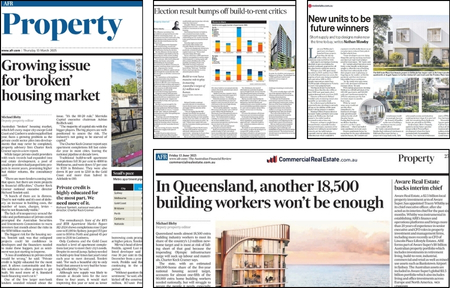As featured in Green Street News
17 September 2025
A new phase of the build-to-sell and build-to-rent residential markets is underway
After a difficult year for the Melbourne build-to-sell and build-to-rent apartment markets, key metrics are starting to shift, and the next cycle has already started, Charter Keck Cramer said in a report shared first with Green Street News.
In its State of the Market Melbourne H1 – 2025, the firm found that overall apartment supply has improved compared to 12 months ago, though is it significantly below the levels required to meet the relevant housing targets. The supply of 3,070 BTS apartments is the lowest amount recorded and underscores the challenging conditions due to pricing inelasticity.
For Melbourne CBD projects launched since 2022, sales were strong for apartments below $17,000/sq m, however units above that pricing level continue to have unsold stock.
National executive director Richard Temlett said 2024 represents the trough and that there will be significant opportunities over the next few years.
“Developers are finding obtaining both planning permission as well as finance the easiest it has been in the last five years, and builders and sub-contractors are also quoting competitively for new work and completing projects ahead of schedule,” he said.
Temlett said demand remains extremely strong and continues to be driven by net overseas migration and residents returning from interstate given the more affordable price points and rents in Melbourne.
“Melbourne is undervalued and holds the greatest upside of all the cities around Australia. The city has since August 2025 already started to re-rate from a pricing perspective,” he said.
He added that how quickly this re-rating happens will depend on interest rates and the state government making the correct policy decisions in light of economic and property market challenges.
“A tipping point is coming where the onerous taxes and charges imposed on Melbourne property will be outweighed by the attractive price point and strong weekly rent (and yields) that could be achieved by new product in Melbourne by investors,” he said. “This will start to manifest as rates continue to fall and the delta between Sydney and Brisbane pricing compared to Melbourne pricing becomes even more pronounced.”
BTR momentum continues to build
Charter Keck also found that BTR has done much of the heavy lifting, with 3,440 apartments (53% of the total supply for FY2025) being delivered.
Temlett said BTR projects are leasing up quickly, and high weekly rents are being achieved.
Data shows BTR platform Home’s buildings at Richmond, Docklands and Southbank are achieving weekly rents of around $1,200, $1,600 and almost $1,800.
“Rental renewals and growth is also meeting the project underwrite across most dwelling typologies and returns are likely to improve with rate reductions,” Temlett said.
He added that some projects are benefiting from accelerated take-up rates, with around 30 to 40 leases per month, and many are reporting stabilised occupancy of around 95% to 98%.
For projects that have been open for more than 12 months, leasing renewal rates are around 70%.
Temlett said the sector continues to evolve and BTR operators have discovered that tenants strong desire amenities such as dog parks, pet washing facilities and co-working facilities.
Financing and international capital chasing BTR
Temlett said there has also been a noticeable increase in activity in the debt space by the Big Four banks, though equity capital remains difficult to raise unless projects are packaged with a development approval and a builder ready to proceed.
Temlett said overseas capital, particularly from Japan, Singapore, South Korea, North America and the Middle East, is also showing significant interest in the BTR asset class.
“The interest in Melbourne is limited to the debt space, whereas in Sydney it is in both the debt and equity space,” he said.
“Our further observations are that overseas capital is also starting to shop around, and we anticipate it to move across platforms, operators and projects over the next 2-3 years. We also anticipate that there will be a consolidation of platforms and operators as the sector evolves.”



